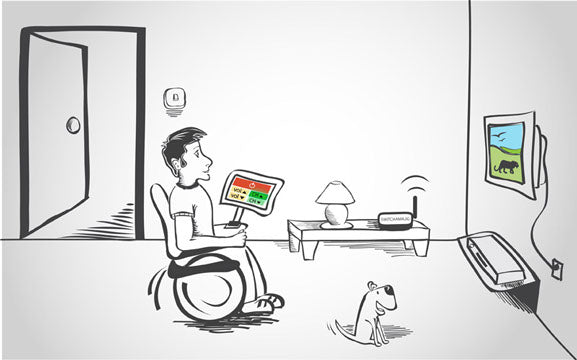Image Source - (Switchamajig)
The assistive technology market has seen several impactful trends over the past decade as technology has continued to evolve. Many devices have become obsolete with the introduction of media convergence creating more activities built in to just one device. Today, individuals with physical disabilities have a wide range of devices to choose from to fit their specific needs and provide a sense of independence. We've highlighted the most common types of assistive technologies used by individuals with physical and communication impairments.
Adaptive Switches

An 'adaptive' or 'assistive' switch is a device that allows the individuals with physical disabilities to independently activate switch-enabled devices, such as a smartphone. tecla-e is a switch interface that pairs with adaptive switches to allow users to control even more devices, like home automation systems, and perform even more tasks. With tecla-e, you can pair with up to 8 Bluetooth-enabled devices and switch between them with simply the activation of a switch.
Choosing the right adaptive switch can have many factors, including preference, dexterity, and whether you need a tool that is portable or to use while laying in bed before sleeping. We recently highlighted the 7 most common adaptive switches: joystick, buddy button, chin switch, micro light switch, pillow switch, SCATIR switch, sip-and-puff switch.
Mobility Aids

Depending on the severity and type of mobility impairment, a different device may be used by an individual. For example, an individual with quadriplegia may use an electric wheelchair controlled by an adaptive switch or joystick and an injured veteran may use a prosthetic device. Other mobility aids include wheelchairs, scooters, walkers, canes, crutches, and orthotic devices.
Environmental Control Devices
Environmental control uses an alternate input device to control one or more electronic appliances such as lights, televisions, and electronically controlled doors. Traditional can be expensive, require complex installation, and aren't easily integrated with many mainstream technology brands. Unlike these devices, tecla-e is compatible with IFTTT-enabled smart home devices which users can control through the tecla-e app or switches connected directly to it. So, users can turn their tv on or off, turn up the heat on their Nest thermostat or adjust the lighting of their Philips Hue lights with tecla-e.
Eye Trackers

Image Source - (Hackaday.com)
Eye trackers are a communication and control system that enables individuals with disabilities that restrict speech to communicate and interact with the world with their eyes. By looking at control icons or data displayed on a screen, a user can generate speech either by typing a message or by choosing from a selection of phrases. A video camera monitors eye behaviour as an input for a command on the device, much like using a computer mouse. Eye trackers have gained a lot of media attention lately due to its novel technology, but it may not be the best solution for you. Ask an assistive technology consultant or occupational therapist about whether switch access or eye tracking is better based on how often you want to access mobile technology.
Voice Recognition Software

Voice recognition software is currently integrated into mainstream devices like voice assistants and smartphones. For smartphones, the 'speech-to-text' tool feature is integrated into both Android and Apple devices to allow users to quickly type a message hands-free. Voice assistants can be found in both smartphones as well as smart speakers like Amazon Echo and use voice recognition software to answer questions, control smart home technology, set reminders and other tasks that increase productivity. Voice recognition software is also used as a stand-alone program for individuals with physical disabilities and dexterity impairments. Programs like Dragon NaturalSpeaking convert human language into text so users can do anything from searching Google hands-free to writing an essay with their voice.



2 comments
Sep 09, 2019 • Posted by doug
My brother has lost all of his fingers and thumbs.Are there any devices available that he could use to interact with his world.
Apr 11, 2018 • Posted by Robert Chase
What a great Invention you are submitted. This is a very helpful post for my grandfather. I read your full article and get some informative information about mobility aids. My grandfathers need one a mobility service. You have shared valuable equipment to use disability people. I am very happy to read your blog. I am full of inspired now to purchasing a service for my grandfather. You are so creative. Thanks for sharing your great post.
Leave a comment: